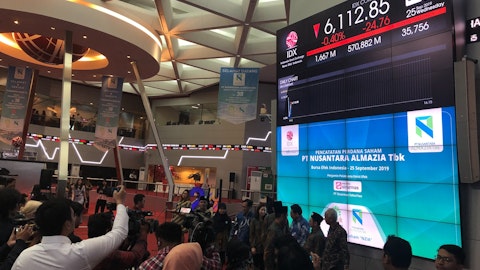We will have some interest rate benefit continuing through next year because of the timing of when those assets when — were placed this year. And those are really the big drivers. The third one is just the fact that health care costs keep going up and so from a spend perspective, we have historically seen spends increase year-over-year as well.
Mihir Bhatia: Got it. And then just switching gears maybe to the Corporate Payments segment. And again, I apologize, I’m just going to ask you a 2-part question here. One is on the third-party volume in that segment. It looks like it’s been slowing down pretty dramatically — well, my word dramatically, this year — through the year. Is there a driver there? Was there any customer loss or anything happened there that that’s driving it? And then just on the travel side of this volume question, have you seen any softness from the rising, I guess, the situation in the Middle East or anything like that where you’re starting to hear a little bit of softness from the airlines. Are you seeing any of those impacts coming through in your early data?
Melissa Smith: So in Corporate Payments, on the travel side, we’re not seeing an impact at this point in time, but we do tend to lag with our data because we’re booking revenue when people are staying on location as opposed to when they’re upfront making the bookings. The EMEA region is a pretty small part, though, of our overall portfolio. It’s just a couple of percentage points, that’s pretty small. And then relating to the other part of Corporate Payments. There’s a couple of things that have impacted the spend year-over-year. The biggest one is that we — during the peak last year of some of the shipping issues our Mobility customers were using Corporate Payments products to pay demurrage fees, which had actually a pretty high rate associated with that.
So you’re seeing an impact both in terms of volume and rate, and this is affecting mix this year comparatively to last year. But nothing notable from a customer loss perspective. There’s some smaller onetime noise type of thing, that’s probably the biggest one.
Jagtar Narula: I do want to emphasize that the nontravel volume was up pretty substantially, 11% year-over-year. So I think you made reference to volumes declining. And I just wanted to emphasize the volumes were up.
Mihir Bhatia: Sorry, what I was referring to there was the third-party volume within corporate — within the Corporate Payments segment, I guess, the stuff where you all are doing it — where you’re doing it for your bank partners, et cetera. That’s what I was talking about. I do think it’s down. I think it’s only up like 1%, like if we do the math, but it looks like that’s slowed down. That’s what I was talking about. But I think you answered my question in general.
Operator: Your next question comes from the line of Sanjay Sakhrani.
Sanjay Sakhrani: I’ve got a question on the health and employee segment as well. When I look at some of the account growth and the volume growth, those decelerated, but the revenues remain strong. Is that a census? Or is there something else that drove sort of the outperformance on revenues?
Jagtar Narula: So I’d say there was a few impacts, Sanjay, into the growth this year. So we did the nonbank custodian side of the business has been growing quite robustly. We had benefit from year-over-year account growth. We had about $3.2 billion of assets last year, closer to $3.7 billion this year, also had the benefit of higher interest rates. That was about a $21 million impact year-over-year. And then we did have about $3 million of revenue from expenses in the quarter. So a minor impact, but that had an impact as well.
Sanjay Sakhrani: Got it. Got it. And then, Jagtar, you mentioned the swaps for next year, understand like this year, probably not as big an impact, is there an impact that we need to think about next year?
Jagtar Narula: Yes. So if you take, I think, the swaps on average are about 1.8%-ish. Well, if you take then going over to our reference rate, 30-day SOFR, your — you’ve got about a $15 million impact next year.
Sanjay Sakhrani: Okay. And is that mitigated with anything? Or just…
Jagtar Narula: Well, we — I would expect that $15 million to flow into the P&L next year. We do, from an overall perspective, as I’ve talk through a few times, we try to manage our overall interest rate risk to be close to neutral with HSA — the HSA assets on our balance sheet against the commercial debt. But in this particular case, with the swaps rolling off, we do expect that to be a $15 million impact to P&L.
Melissa Smith: And Sanjay, just we’re putting that out just to make sure people had picked that up in their models. We are still just to reiterate what I said in the beginning, we’re gearing the company to the 10% to 15% top line growth and 15% to 20% bottom line growth price, FX and price adjusted. Now, like so — we just want to make sure people are picking up that piece in their model.
Sanjay Sakhrani: Got it. Could I just add one — ask one last question on Payzer. I know you got a lot of them. Just in terms of — you mentioned the use cases being HVAC, plumbing, roofing, I guess like is the inside you’re — that identified clients that you mentioned, the 150,000, I guess, are those in those verticals? And can the use cases be expanded for Payzer?
Melissa Smith: So the 150,000 includes everybody in field services management, which is more expansive so think lawn care to some of the construction, specialty trades, machine repairs, pest control. And so we are very much — so if you look at Payzer, they are focused more on HVAC. So some of the initial verticals are more specialized. Our focus right now is around exposing Payzer to the customers that are in their specific specialty trades that they are targeting right now. And then once we see success in that, then we may adopt the product to have broader applications. And so to your point, we’re hyper focused on the specific subsection of our customers that are overlapping with their product capability right now. But from a — the eye on the prize that we’re targeting long term is 150,000 customers that we have.





